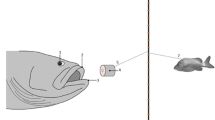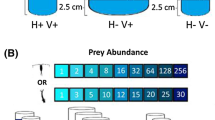Summary
Two of the parameters which determine the rate at which prey are encountered by a predator, i.e. the distance at which a predator responds to a prey and its rate of movement relative to the prey's, were determined for all the stages of five species of Gerris using gerrids and Drosophila as prey. These parameters allowed calculation of the swath, or “encounter path”, a gerrid would cover as it moved across the water surface.
Gerris species prefer to attack live prey in front of them, and tend to ignore prey if the attack requires a turn of more than 100°. Hunger was found to affect the responsive angle required to clicit an attack by G. remigis, and regardless of species, smaller gerrids required the prey to be closer before an attack was initiated. The rate of movement in Gerris was measured as a function of stride length and the number of strides made per unit time. Stride length varied according to the length of the mesothoracic leg, and the frequency of movement was observed to be species specific. G. remigis, a stream species, moved 4–6 times as often as the four other species studied, all of which are characteristically found on non-moving water surfaces. Within a species, gerrid size had no significant effect on the frequency of movement, although there was a tendency for smaller gerrids to move less.
Similar content being viewed by others
References
Dawkins, R.: A cheap method of recording behavioral events, for direct computer-access. Behavior 40, 162–173 (1972)
Holling, C.S.: The functional response of predators to prey density and its role in mimicry and population regulation. Mem. ent. Soc. Can. No. 45, 60 p (1965)
Jamieson, G.S.: Coexistence in the Gerridae. Ph.D. Dissertation, University of British Columbia, Vancouver, B.C., Canada (1973)
Jamieson, G.S., Scudder, G.G.E.: Food consumption in Gerris (Hemiptera). Oecologia, 23–41 (1977)
Liche, H.: Beobachtungen über das Verhalten der Wasserläufer (Gerridae, Hemiptera, Heteroptera). Bull. int. Acad. Pol. sci. B2, 525–546 (1936)
Meyer, H.W.: Visuelle Schlüsselreize für die Auslösung der Beutefanghandlung beim Bachwasserläufer Velia caprai (Hemiptera, Heteroptera). 1. Untersuchung der räumlichen und zeitlichen Reizparameter mit formverschiedenen Attrappen. Z. vergl. Physiol. 72, 260–297 (1971a)
Meyer, H.W.: Visuelle Schlüsselreize für die Auslösung der Beutefanghandlung beim Bachwasserläufer Velia caprai (Hemiptera, Heteroptera). Untersuchung der Wirkung zeitlicher Reizmuster mit Flimmerlicht. Z. vergl. Physiol. 72, 298–342 (1971b)
Murphey, R.K.: Motor control of orientation to prey by the waterstrider, Gerris remigis. Z. vergl. Physiol. 72, 150–167 (1971a)
Murphey, R.K.: Sensory aspects of the control of orientation to prey by the waterstrider, Gerris remigis. Z. vergl. Physiol. 72, 168–185 (1971b)
Rensing, L.: Beiträge zur vergleichenden Morphologie, Physiologie und Ethologie der Wasserläufer (Gerroidea). Zool. Beitr. Berlin 7, 447–485 (1962)
Author information
Authors and Affiliations
Rights and permissions
About this article
Cite this article
Jamieson, G.S., Scudder, G.G.E. Predation in Gerris (Hemiptera): Reactive distances and locomotion rates. Oecologia 44, 13–20 (1979). https://doi.org/10.1007/BF00346390
Received:
Issue Date:
DOI: https://doi.org/10.1007/BF00346390




